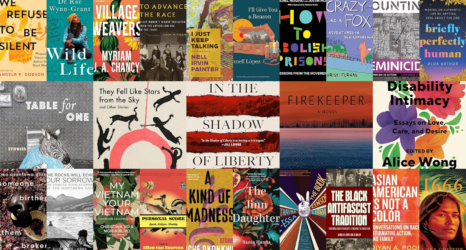There has been much debate about whether Islam needs to be reformed, or if Islam needs a sexual revolution. Middle East correspondent and non-believer Carla Power teamed up with moderate Muslim leader Shaykh Mohammad Akram Nadwi to go back to the very beginning, to the Quran. For 365 days, they read the words directly on the page.
After September 11, Power noticed that the gap of understanding of Islam in the media widened instead of narrowed. Images of women in burqas and stories of honor killings painted Islam as an intolerant religion. She hoped that by going back to the 1,400-year-old source, instead of reading watered-down interpretations from extremists, she could find out what was really there.
Did oppressive cultural practices stem from the religion’s theology? Or was it a more modern—and extremist—interpretation? Her yearlong journey of reading the actual texts in the Quran resulted in a book: If the Oceans Were Ink: An Unlikely Friendship and a Journey to the Heart of the Quran.
Below are the top four things Power learned about Islam and women.
- The Quran is full of interesting and strong women:
The Prophet Muhammad’s beloved first wife, Khadija, was his boss. She was a successful caravan businesswoman in Makkah. The Prophet, who later became the most important man in Islam, was a penniless orphan with charm but no status. Khadija was a single mother who was twice widowed and 15 years his senior. He was 25. They were monogamous for 24 years, and it is widely believed that she was the love of his life. After her death, he married other wives, though mostly for political reasons.
Aisha, his only virgin wife, was feisty and her voice is prevalent in 2,210 hadiths. A hadith consists of the words or deeds of the Prophet, and is considered to be the second authority in Islam after the Quran. Much of what we know about matters of prayers, trade and sex are attributed to Aisha, Power writes. Aisha debated with men and the Prophet respected her opinion. “Take half your religion from Humayra [‘The Little Rosy One,’ Aisha’s nickname],” the Prophet is said to have told his companions.
- Women should have agency within a marriage:
Marriage is known in Islam as “half of the religion.” That means that half of the laws and obligations in Islam are directly related to a union of matrimony. There is a story of a girl who came to the Prophet’s wife distressed at being forced to marry against her will. The Prophet told the young girl, “then your marriage is invalid.” Contrary to popular belief, divorce was permissible during the time of the Prophet, and his wives had the choice to divorce him. None did.
Many verses of the Quran were revealed while the Prophet was with his wives. In Islam, a husband is permitted to have up to four wives, as long as he treats all of the women equally. The percentage of Muslim men marrying multiple wives today is small. Historically, many married multiple wives to protect widowed women and those with poor families. Muslims accept that the Prophet was an exception by marrying about 13 wives in total. It is important to note that at the time of the Prophet, more than 1,400 years ago, polygamy was widespread. Having that many wives meant that the Prophet constantly had at least a dozen women around him. He openly allowed them to influence him and his decisions, and many rules came into place after a woman asked a question.
- There are many badass Islamic women scholars:
Nadwi, the sheikh who Power studied with, wanted to publish a pamphlet on Islamic women to challenge the notion that women in Islam were not present at the time of the Prophet. To his amazement, he found thousands of women scholars to include, which he turned into 40 volumes. The work, al-Muhaddithat: The Women Scholars in Islam, challenged such myths. “I do not know of another religious tradition in which women were so central, so present, so active in its formative history,” Nadwi wrote. Power mentions how “in traditional Judaism, women didn’t learn or teach the Torah, and…Christianity’s clergy was until relatively recently an all-male affair.” Islam seemed to always have women as important figures and influencers.
“Given the tradition of the unnamed woman, the 9,000 women the Sheikh had found were probably just a fraction of the female Islamic scholars through history,” Power writes.
- Islamic customs weren’t always “sexist”:
“Few garments, if any, have been freighted with more debate than the Muslim veil. Mullahs pontificate on the proper sheerness, length and style. Governments, both Muslim and Western, have used it as a plank in policy strategies,” Power writes. One of the central parts of the anti-feminist criticism against Islam is leveled at the niqab, the fabric partition that covers the woman’s face, aside from a slit for her eyes.
“Laws don’t make people pious,” Nadwi said, “They protect piety when it is already there. Clothes don’t make you pious.”
Medieval scholars made veiling customs the rule, after it was considered fashionable by the elite. According to historian Leila Ahmed, the Prophet’s wives were the only ones who veiled during his lifetime, and after his death, others followed.
“Veiling, like seclusion, was observed only by his [the Prophet’s] wives,” Power quotes Ahmed in the book. “The veil’s prevalence in the Muslim community came later.”
Like in India and China, there was an old Arab custom of burying newborn daughters while alive. When Islam came, it forbid it. All Muslims pray in a row together, in uniform and organized rows. Islam doesn’t favor one person over another in prayer, regardless of wealth or power. While men and women pray in different rows, those in each row are all equal and a princess and a janitor stand side-by-side. A popular hadith says: “Paradise is under the feet of the mothers.” No such claim was given to fathers. There is also an entire sura called al-Nisa (the Women) and none dedicated to men.
Power concludes the book by saying that the misinterpretations and misconceptions seem to thrive when the majority is punished for the actions of the rowdy minority:
If Muslims rarely make it into the papers as three-dimensional human beings, there is also scant appetite in the mainstream Western media for what their scripture actually says. Never, in my 17 years of writing magazine stories on the Islamic world, had an editor asked me to write about, or even cite, the Quran, and how Muslims understand it.
Only nearing the end of our lessons did I recognize the irony of the year’s project. Studying the Sheikh’s faith had allowed me to practice mine…Without a year trying to see the world from Akram’s vantage, I wouldn’t be able to make out the contours of my own.





